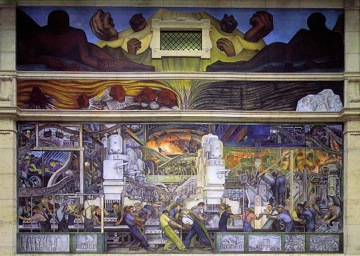
Diego Rivera, Detroit Industry, 1932-33. North Wall at the Detroit Institute of the Arts.
I must say I’m finding the vociferous opposition in Congress over the allocation of a mere $50 million dollars to the National Endowment for the Arts to help strengthen arts institutions (as part of the $800+ billion economic stimulus package!) pretty disheartening. Despite the relatively lavish attention given to arts policy by the Obama campaign and ambitious proposals put forth for support of artists and arts education, it very much remains to be seen how the recent changes in the political landscape might affect the way art is produced and presented in the United States.
As you probably know, Obama convened an extraordinary group of arts leaders to advise him in the early stages of his campaign. The platform was centered on “reinvesting in arts education,” with significant planks for supporting individual artists through providing affordable health care, ensuring tax fairness for artists, and promoting cultural exchange.
More detailed policy recommendations were presented to the Obama transition team by the Performing Arts Policy Group, crafted with input from visual arts and literature organizations in addition to representatives from the music, dance, and theatre communities. This must-read document includes recommendations for the expansion of the NEA, arts education, and cultural diplomacy initiatives as well as the creation of an “artists corps” and the appointment of a senior level official to coordinate arts and cultural policy.
Much of the debate since Obama’s election has centered on the question of whether the senior arts policy position should be a cabinet-level office that directs policy, or something akin to the Office of Science and Technology, which is more advisory. Quincy Jones is perhaps the most high-profile proponent of creating a cabinet-level “Secretary of the Arts”; prior to the election he claimed he’d “beg” Obama for it, though there is also a much quoted New York Times editorial by William Ferris, the former chairman of the National Institute of the Humanities, that forcefully made this plea.
Richard Serra (Season 1) was more ambivalent on the question of whether the position should be cabinet-level, but has added his voice to the call (literally in Studio 360’s “Voicemail for Barack” series).
There are also those that argue against a cabinet-level position: the Wall Street Journal, for one. And Tyler Green at Modern Art Notes argues against a cabinet-level position in favor of the Office of Science and Technology Policy model.
Of course, underlying so many of the questions at stake are the extreme challenges to artists, non-profit arts institutions, and arts education programs posed by the current recession. Green is eloquent on the subject: “At a time when the federal government is spending around $1 trillion to prop up the economy and to bail out failed businesses (with more dollars apparently on the way), it’s shameful that there is yet no federal effort to ensure that financially troubled but nationally important, programmatically successful cultural institutions (many of which are also economically important to their regions) receive economic assistance too.” Equally articulate is Michael Kaiser in his Washington Post editorial, “No Bailout for the Arts?” (Kaiser heads the Kennedy Center for Performing Arts).
Indeed, one of the major arguments for creating a senior arts policy position is to call national attention to the contributions of artists and arts institutions to our quality of life and the vibrancy of our economy. The “bailout bill” that just passed in the House of Representatives does include $50 million in recovery funds for the NEA, but the Senate version of the bill does not. I was particularly struck by the first comment on last week’s New York Times Arts Beat post about the bailout bill that asked “what is arts infrastructure?” forcefully underscoring the need for leadership and advocacy for the arts at the federal level.
As someone who deals with the challenges of funding for Art21 on a day to day basis, I can see very clearly the benefits to having strong national leadership on arts policy. But we’d like to hear from you. What changes would you like to see made? How might the appointment of a senior arts policy adviser affect your lives as artists, teachers, writers, art lovers, etc.?
Beth Allen is Director of Development for Art21.




Pingback: Hope and Change, Part 2 | Art21 Blog
Pingback: Flash Points: Art+Politics, Looking Back & Moving Forward | Art21 Blog